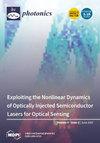低损耗、高双折射准对称中空芯反谐振光纤的设计与研究
IF 2.1
4区 物理与天体物理
Q2 OPTICS
引用次数: 0
摘要
用于红外波段的低损耗、高双折射、抗弯曲的空芯抗谐振光纤在精密干涉传感、激光系统和光通信领域有着重要的应用。本文提出了一种八管包层准对称空芯抗谐振光纤,并基于这种光纤结构设计了另外两种抗谐振光纤。采用有限元分析方法对优化设计后的三种光纤的极限损耗、双折射系数、抗弯强度等性能进行了数值分析。结果表明,三种光纤在λ = 1.55 μm时的极限损耗均小于10-4量级,双折射系数均达到10-4量级;同时,三种光纤各有特点和优势,第一种光纤在λ = 1.52 μm时的双折射系数可达9.25×10-4,λ = 1.55 μm时的极限损耗为3.42×10-5 dB/km。三种反谐振光纤的最小弯曲半径均小于 40 mm,弯曲特性良好,其中八管包层准对称光纤在弯曲半径为 28 mm 时的弯曲损耗小于 2.10 × 10-3 dB/km。这三种光纤在改善低极限损耗和高双折射之间的相互制约方面取得了良好的效果,效果优于其他两种光纤。这些成果具有很高的开发潜力。本文章由计算机程序翻译,如有差异,请以英文原文为准。
Design and Study of Low Loss, High Birefringence Quasi-Symmetric Hollow-Core Anti-Resonant Fiber
Low-loss, high-birefringence, bend-resistant hollow-core anti-resonant fibers for infrared wavelengths have important applications in the fields of precision interferometric sensing, laser systems, and optical communications. In this paper, an eight-tube cladding quasi-symmetric hollow-core anti-resonant fiber is proposed, and two other anti-resonant fibers are designed based on this fiber structure. The finite element analysis method is used to numerically analyze the limiting loss, birefringence coefficient, bending resistance, and other properties of the three optical fibers after the optimized design. The results show that the limiting loss of the three optical fibers at λ = 1.55 μm is lower than 10−4 magnitude, and all of them obtain a birefringence coefficient of 10−4 magnitude; at the same time, the three optical fibers have their own characteristics and advantages, and the first optical fiber can reach a birefringence coefficient of 9.25 × 10−4 at λ = 1.52 μm.The limiting loss at λ = 1.55 μm is 3.42 × 10−5 dB/km. The minimum bending radius of the three types of anti-resonant fibers is less than 40 mm, which represents good bending characteristics, and the eight-tube cladding quasi-symmetric optical fiber has a bending loss of less than 2.10 × 10−3 dB/km when the bending radius is 28 mm. The three types of optical fibers have obtained good results in improving the mutual constraints between low limiting loss and high birefringence, with better results than the other two types. The obtained results have high development potential.
求助全文
通过发布文献求助,成功后即可免费获取论文全文。
去求助
来源期刊

Photonics
Physics and Astronomy-Instrumentation
CiteScore
2.60
自引率
20.80%
发文量
817
审稿时长
8 weeks
期刊介绍:
Photonics (ISSN 2304-6732) aims at a fast turn around time for peer-reviewing manuscripts and producing accepted articles. The online-only and open access nature of the journal will allow for a speedy and wide circulation of your research as well as review articles. We aim at establishing Photonics as a leading venue for publishing high impact fundamental research but also applications of optics and photonics. The journal particularly welcomes both theoretical (simulation) and experimental research. Our aim is to encourage scientists to publish their experimental and theoretical results in as much detail as possible. There is no restriction on the length of the papers. The full experimental details must be provided so that the results can be reproduced. Electronic files and software regarding the full details of the calculation and experimental procedure, if unable to be published in a normal way, can be deposited as supplementary material.
 求助内容:
求助内容: 应助结果提醒方式:
应助结果提醒方式:


